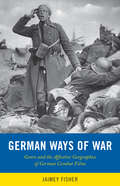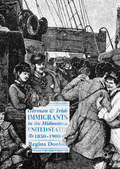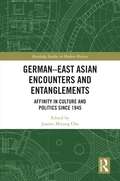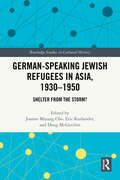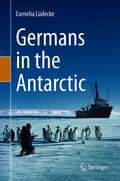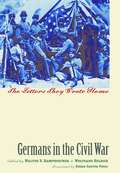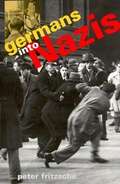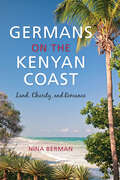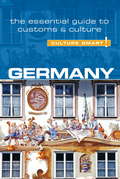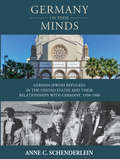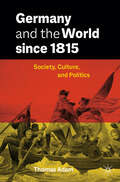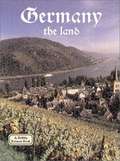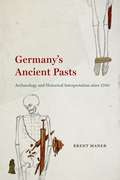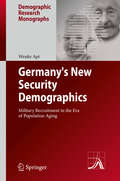- Table View
- List View
German Ways of War: The Affective Geographies and Generic Transformations of German War Films (War Culture)
by Jaimey FisherGerman Ways of War deploys theories of space, mobility, and affect to investigate how war films realize their political projects. Analyzing films across the decades, from the 1910s to 2000s, German Ways of War addresses an important lacuna in media studies: while scholars have tended to focus on the similarities between cinematic looking and weaponized targeting -- between shooting a camera and discharging a gun – this book argues that war films negotiate spaces throughout that frame their violence in ways more revealing than their battle scenes. Beyond that well-known intersection of visuality and violence, German Ways of War explores how the genre frames violence within spatio-affective operations. The production of novel spaces and evocation of new affects transform war films, including the genre’s manipulation of mobility, landscape, territory, scales, and topological networks. Such effects amount to what author Jaimey Fisher terms the films’ “affective geographies” that interweave narrative-generated affects, spatial depictions, and political processes.
German Women for Empire, 1884-1945
by Lora WildenthalWhen Germany annexed colonies in Africa and the Pacific beginning in the 1880s, many German women were enthusiastic. At the same time, however, they found themselves excluded from what they saw as a great nationalistic endeavor. In German Women for Empire, 1884-1945 Lora Wildenthal untangles the varied strands of racism, feminism, and nationalism that thread through German women's efforts to participate in this episode of overseas colonization. In confrontation and sometimes cooperation with men over their place in the colonial project, German women launched nationalist and colonialist campaigns for increased settlement and new state policies. Wildenthal analyzes recently accessible Colonial Office archives as well as mission society records, periodicals, women's memoirs, and fiction to show how these women created niches for themselves in the colonies. They emphasized their unique importance for white racial "purity" and the inculcation of German culture in the family. While pressing for career opportunities for themselves, these women also campaigned against interracial marriage and circulated an image of African and Pacific women as sexually promiscuous and inferior. As Wildenthal discusses, the German colonial imaginary persisted even after the German colonial empire was no longer a reality. The women's colonial movement continued into the Nazi era, combining with other movements to help turn the racialist thought of the late-nineteenth and early-twentieth centuries into the hierarchical evaluation of German citizens as well as colonial subjects. Students and scholars of women's history, modern German history, colonial politics and culture, postcolonial theory, race/ethnicity, and gender will welcome this groundbreaking study.
German and Irish Immigrants in the Midwestern United States, 1850–1900
by Regina DonlonIn the second half of the nineteenth century, hundreds of thousands of German and Irish immigrants left Europe for the United States. Many settled in the Northeast, but some boarded trains and made their way west. Focusing on the cities of Fort Wayne, Indiana and St Louis, Missouri, Regina Donlon employs comparative and transnational methodologies in order to trace their journeys from arrival through their emergence as cultural, social and political forces in their communities. Drawing comparisons between large, industrial St Louis and small, established Fort Wayne and between the different communities which took root there, Donlon offers new insights into the factors which shaped their experiences—including the impact of city size on the preservation of ethnic identity, the contrasting concerns of the German and Irish Catholic churches and the roles of women as social innovators. This unique multi-ethnic approach illuminates overlooked dimensions of the immigrant experience in the American Midwest.
German and United States Colonialism in a Connected World: Entangled Empires (Cambridge Imperial and Post-Colonial Studies)
by Janne LahtiThis book contributes to global history by examining the connected histories of German and United States colonial empires from the early nineteenth century to the Nazi era. It looks at multiple and multidirectional flows, transfers, and circulations of ideas, people, and practices as Germany and the US were embedded in, and created by, an interconnected world of empires. This relationship was not exceptional, but emblematic of the diverse entanglements that created colonial globality.Colonial entanglements between Germany and the United States took on many forms, but these shared and intersecting histories have been underanalyzed. Traditionally, Germany and the United States have been understood to have taken, respectively, an authoritarian and liberal path into modernity. But there is no neat dichotomy, as the contributors to this book illustrate. There are many more similarities than have previously been appreciated – and they are the result of multilayered entanglements made visible via conquest, settler societies, racialization, and rule of difference. Building on present historiographies of empires, colonialism, and globalization, this book introduces new analytical possibilities for examining these two relatively understudied empires alongside each other, as well as at their intersections.Chapter 1 is available open access under a Creative Commons Attribution 4.0 International License via link.springer.com.
German-East Asian Encounters and Entanglements: Affinity in Culture and Politics Since 1945 (Routledge Studies in Modern History #75)
by Joanne Miyang ChoThis volume surveys transnational encounters and entanglements between Germany and East Asia since 1945, a period that has witnessed unprecedented global connections between the two regions. It examines their sociopolitical and cultural connections through a variety of media. Since 1945, cultural flow between Germany and East Asia has increasingly become bidirectional, spurred by East Asian economies’ unprecedented growth. In exploring their dynamic and evolving relations, this volume emphasizes how they have negotiated their differences and have frequently cooperated toward common goals in meeting the challenges of the contemporary world. Given their long-standing historical differences, their post-1945 relations reveal a surprisingly high degree of affinity in many areas. To show how they have deeply shaped each other’s views, this volume presents 12 chapters by scholars from the fields of history, sinology, sociology, literature, music, and film. Topics include cultural topics, such as German and Swiss writers on East Asia (Enzensberg, Muschg, and Kreitz), Japanese writer on Germany (Tezuka and Tawada), German commemorative culture in Korea, Beethoven in China, metal music in Germany and Japan, diary films on Japan (Wenders), as well as sociopolitical topics, such as Sino– East German diplomacy, Germans and Korean democracy, and Japanes and Korean communities in Germany.
German-Speaking Jewish Refugees in Asia, 1930–1950: Shelter from the Storm? (Routledge Studies in Cultural History)
by Joanne Miyang Cho Eric Kurlander Doug McGetchinAlthough most perished, hundreds of thousands of Central European Jews escaped the Holocaust; tens of thousands of these Jewish refugees ended up in East Asia, Southeast Asia, or South Asia. Taking a global and transnational approach, this volume examines the cultural, political, and socioeconomic encounters among and between Asian and European states and empires, Central European Jews, and Asians between 1930 and 1950, offering important case studies that address the policies toward and experiences of German-speaking Jews across East Asia, Southeast Asia, and South Asia.The strength of this volume lies not only in its efforts to include multiple theoretical perspectives, which integrate German, Jewish, Asian, and Migration Studies, but also in the original empirical research on which it is based. Engaging directly with the rich and growing historiography on the origins, course, and consequences of the Holocaust in East, Southeast, and South Asia, this volume provides a framework in which we can better understand how global traditions of empire and colonialism matter in our efforts to understand the Holocaust, while indicating that Asian states and peoples were keenly aware of the so-called “Jewish Question” and made efforts, though widely differentiated, to provide shelter from the Nazi storm.German-Speaking Jewish Refugees in Asia, 1930–1950 will appeal to students and scholars alike interested in the history of Jewish refugees in the twentieth century, as well as all those interested in the modern history of German-speaking Central Europe and Asia.
Germans and Texans
by Walter StruveDuring the brief history of the Republic of Texas (1836-1845), over 10,000 Germans emigrated to Texas. Perhaps best remembered today are the farmers who settled the Texas Hill Country, yet many of the German immigrants were merchants and businesspeople who helped make Galveston a thriving international port and Houston an early Texas business center. This book tells their story.Drawing on extensive research on both sides of the Atlantic, Walter Struve explores the conditions that led nineteenth-century Europeans to establish themselves on the North American frontier. In particular, he traces the similarity in social, economic, and cultural conditions in Germany and the Republic of Texas and shows how these similarities encouraged German emigration and allowed some immigrants to prosper in their new home. Particularly interesting is the translation of a collection of letters from Charles Giesecke to his brother in Germany which provide insight into the business and familial concerns of a German merchant and farmer.This wealth of information illuminates previously neglected aspects of intercontinental migration in the nineteenth century. The book will be important reading for a wide public and scholarly audience.
Germans in Louisville: A History (American Heritage Ser.)
by C. Robert Ullrich and Victoria A. UllrichDiscover the German influence on the Derby City in this collection of historical essays. The first German immigrants arrived in Louisville nearly two hundred years ago. By 1850, they represented nearly twenty percent of the population, and they influenced every aspect of daily life, from politics to fine art. In 1861, Moses Levy opened the famed Levy Brothers department store. Kunz&’s &“The Dutchman&” Restaurant was established as a wholesale liquor establishment in 1892 and then became a delicatessen and, finally, a restaurant in 1941. Carl Christian Brenner, an emigrant from Lauterecken, Bavaria, gained notoriety as the most important Kentucky landscape artist of the nineteenth century. C. Robert and Victoria A. Ullrich edit a collection of historical essays about German immigrants and their fascinating past in the Derby City.
Germans in the Antarctic
by Cornelia LüdeckeWhile science was usually at the forefront of German Antarctic expeditions, research into the Southern Polar region always had a political or economic component, whether it was about resource use or securing areas of influence.Cornelia Lüdecke presents the course of the three German Antarctic expeditions from 1901-03, 1911-12 and 1938/39 with their partly dramatic turns and twists and provides insights into everyday life under extreme conditions.She also evaluates unpublished material from the archives and private estates of the expedition members. She looks at the expeditions from a scientific and political point of view and also deals with the myths associated with the "Schwabenland" expedition during the National Socialist era.Finally, the author describes German south polar research after World War II, which took different paths in the German Democratic Republic and in the Federal Republic of Germany, and gives an outlook on future research. For the first time, this book presents the history of the Germans in Antarctica in a factual and informative way for the general public. With numerous pictures, some of which have never been published before.
Germans in the Civil War
by Walter D. Kamphoefner Wolfgang HelbichGerman Americans were one of the largest immigrant groups in the Civil War era, and they comprised nearly 10 percent of all Union troops. Yet little attention has been paid to their daily lives--both on the battlefield and on the home front--during the war. This collection of letters, written by German immigrants to friends and family back home, provides a new angle to our understanding of the Civil War experience and challenges some long-held assumptions about the immigrant experience at this time. Originally published in Germany in 2002, this collection contains more than three hundred letters written by seventy-eight German immigrants--men and women, soldiers and civilians, from the North and South. Their missives tell of battles and boredom, privation and profiteering, motives for enlistment and desertion and for avoiding involvement altogether. Although written by people with a variety of backgrounds, these letters describe the conflict from a distinctly German standpoint, the editors argue, casting doubt on the claim that the Civil War was the great melting pot that eradicated ethnic antagonisms.
Germans into Nazis
by Peter FritzscheIn this dramatically plotted book, organized around crucial turning points in 1914, 1918, and 1933, Peter Fritzsche explains why the Nazis were so popular and what was behind the political choice made by the German people.
Germans on the Kenyan Coast: Land, Charity, and Romance
by Nina Berman“Shed[s] light on the romantic, psychosexual and psychosocial, and economic entanglements that tie German tourists to their Kenyan hosts.” —Daily NationDiani, a coastal town on the Indian Ocean, is significantly defined by a large European presence that has spurred economic development and is also supported by close relationships between Kenyans and European immigrants and tourists. Nina Berman looks carefully at the repercussions that these economic and social interactions have brought to life on the Kenyan coast. She explores what happens when poorer and less powerful members of a community are forced to give way to profit-based real estate development, what it means when most of Diani’s schools and water resources are supplied by funds from immigrants, and what the impact of mixed marriages is on notions of kinship and belonging as well as the economy. This unique story about a small Kenyan town also recounts a wider tale of opportunity, oppression, resilience, exploitation, domination, and accommodation in a world of economic, political, and social change.“In this richly detailed book, Nina Berman tracks the influx of thousands of German-speaking tourists and residents, especially in the 1990s, and the making of a distinctive Kenyan-European cultural enclave in the coastal community of Diani as many of these visitors choose to extend their stay as long-term residents.” —Ann Biersteker, author of Masomo ya Kisasa: Contemporary Readings in Swahili“An informative and thought-provoking work that deserves to be read by scholars of Kenya and those interested in globalized structures of gentrification, north-south humanitarian assistance, and love and romance in Africa.” —African Studies Quarterly
Germans to Poles
by Hugo ServiceAt the end of the Second World War, mass forced migration and population movement accompanied the collapse of Nazi Germany's occupation and the start of Soviet domination in East-Central Europe. Hugo Service examines the experience of Poland's new territories, exploring the Polish Communist attempt to 'cleanse' these territories in line with a nationalist vision, against the legacy of brutal wartime occupations of Central and Eastern Europe by Nazi Germany and the Soviet Union. The expulsion of over three million Germans was intertwined with the arrival of millions of Polish settlers. Around one million German citizens were categorised as 'native Poles' and urged to adopt a Polish national identity. The most visible traces of German culture were erased. Jewish Holocaust survivors arrived and, for the most part, soon left again. Drawing on two case studies, the book exposes how these events varied by region and locality.
Germany (Major European Union Nations)
by Ida WalkerEver since Germany formed in 1871, it has been a major world player. It was even a founding member of the EU in 1952. Although Germany's 20th-century history was often dark, it is now one of the most prosperous and stable countries in the world. It has struggled during the global recession, but it has also been a leader in facing the EU's economic difficulties. Discover more about this exciting, modern nation!
Germany - Culture Smart!
by Barry TomalinCulture Smart! provides essential information on attitudes, beliefs and behavior in different countries, ensuring that you arrive at your destination aware of basic manners, common courtesies, and sensitive issues. These concise guides tell you what to expect, how to behave, and how to establish a rapport with your hosts. This inside knowledge will enable you to steer clear of embarrassing gaffes and mistakes, feel confident in unfamiliar situations, and develop trust, friendships, and successful business relationships.Culture Smart! offers illuminating insights into the culture and society of a particular country. It will help you to turn your visit-whether on business or for pleasure-into a memorable and enriching experience. Contents include* customs, values, and traditions* historical, religious, and political background* life at home* leisure, social, and cultural life* eating and drinking* do's, don'ts, and taboos* business practices* communication, spoken and unspoken"Culture Smart has come to the rescue of hapless travellers." Sunday Times Travel"... the perfect introduction to the weird, wonderful and downright odd quirks and customs of various countries." Global Travel"...full of fascinating-as well as common-sense-tips to help you avoid embarrassing faux pas." Observer"...as useful as they are entertaining." Easyjet Magazine"...offer glimpses into the psyche of a faraway world." New York Times
Germany - Culture Smart!
by Barry TomalinWith the FIFA World Cup in its pocket Germany is feeling its social, political, and economic power once again. After organizing a successful World Cup in 2006 and winning it against Argentina in Brazil in 2014, Germany sees a note of confidence, even triumphalism, permeating the country. As a European leader committed to the success of the EU and the Eurozone, Germany is a leading driver of European affairs. It emerged from the recession of 2008 as the strongest economic power in Europe, and German manufacturing, product brand value, and exports are going from strength to strength. What are the implications of this new world confidence for German society itself? In the last few years we have seen East and West Germany come together socially and achieve a greater degree of economic balance as a long-term result of German re-unification. At the same time German society itself is internationalizing, with increased immigration and the adaptation of age-old values and attitudes to a multinational, multicultural era. Traditional attitudes of formality and rigid protocol in business are softening as German business globalizes. This new, updated edition of Culture Smart! Germany examines these changes. It explains how German traditional values and working methods are adapting to take advantage of international opportunities and global society while maintaining the commitment to quality, organization, and time that marks out German business life. It shows how the traditional differences between Germany's regions are lessening, enabling society to come together and better absorb new immigrants, and above all how Germans are losing the fear and guilt associated with their twentieth-century wars and finding a new voice on the international stage.
Germany On Their Minds: German Jewish Refugees in the United States and Relationships with Germany, 1938–1988 (Studies in German History #25)
by Anne C. SchenderleinThroughout the 1930s and early 1940s, approximately ninety thousand German Jews fled their homeland and settled in the United States, prior to that nation closing its borders to Jewish refugees. And even though many of them wanted little to do with Germany, the circumstances of the Second World War and the postwar era meant that engagement of some kind was unavoidable—whether direct or indirect, initiated within the community itself or by political actors and the broader German public. This book carefully traces these entangled histories on both sides of the Atlantic, demonstrating the remarkable extent to which German Jews and their former fellow citizens helped to shape developments from the Allied war effort to the course of West German democratization.
Germany and the Confessional Divide: Religious Tensions and Political Culture, 1871-1989
by Mark Edward Ruff and Thomas GroßböltingFrom German unification in 1871 through the early 1960s, confessional tensions between Catholics and Protestants were a source of deep division in German society. Engaging this period of historic strife, Germany and the Confessional Divide focuses on three traumatic episodes: the Kulturkampf waged against the Catholic Church in the 1870s, the collapse of the Hohenzollern monarchy and state-supported Protestantism after World War I, and the Nazi persecution of the churches. It argues that memories of these traumatic experiences regularly reignited confessional tensions. Only as German society became increasingly secular did these memories fade and tensions ease.
Germany and the World since 1815: Society, Culture, and Politics
by Thomas AdamThis textbook provides a history of modern Germany, locating the country’s social, cultural, and political developments within their proper global and transnational context. The author argues that most developments in German culture, society, and politics throughout the nineteenth and twentieth centuries were caused by wider global and transnational trends. A history of the German people rather than the German state, the book focusses on non-state and non-government actors, intercultural transfers, and applies the approach of ‘thick description’ to analysing the creation of German culture, society, and identity from the era of the Napoleonic wars right up to the present post-unification Germany. This includes an examination of German migrants’ journeys to their new homes in the Americas and, thus, the creation of a global German diaspora with cultural and social networks beyond its home country’s borders. The book further focusses on the transfers that connected German society and culture with those of other countries; for instance, chapters cover the transfer of football from England to Germany, the transfer of the Christmas holiday tradition from Germany to other countries, and the development of eugenics in Germany within its global context.
Germany the Land (Lands, Peoples, and Cultures Ser.)
by Kathryn LaneIntroduces the geography, cities, transportation, economy, and wildlife of Germany.
Germany's Ancient Pasts: Archaeology and Historical Interpretation since 1700
by Brent ManerIn Germany, Nazi ideology casts a long shadow over the history of archaeological interpretation. Propaganda, school curricula, and academic publications under the regime drew spurious conclusions from archaeological evidence to glorify the Germanic past and proclaim chauvinistic notions of cultural and racial superiority. But was this powerful and violent version of the distant past a nationalist invention or a direct outcome of earlier archaeological practices? By exploring the myriad pathways along which people became familiar with archaeology and the ancient past—from exhibits at local and regional museums to the plotlines of popular historical novels—this broad cultural history shows that the use of archaeology for nationalistic pursuits was far from preordained. In Germany’s Ancient Pasts, Brent Maner offers a vivid portrait of the development of antiquarianism and archaeology, the interaction between regional and national history, and scholarly debates about the use of ancient objects to answer questions of race, ethnicity, and national belonging. While excavations in central Europe throughout the eighteenth and nineteenth centuries fed curiosity about the local landscape and inspired musings about the connection between contemporary Germans and their “ancestors,” antiquarians and archaeologists were quite cautious about using archaeological evidence to make ethnic claims. Even during the period of German unification, many archaeologists emphasized the local and regional character of their finds and treated prehistory as a general science of humankind. As Maner shows, these alternative perspectives endured alongside nationalist and racist abuses of prehistory, surviving to offer positive traditions for the field in the aftermath of World War II. A fascinating investigation of the quest to turn pre- and early history into history, Germany’s Ancient Pasts sheds new light on the joint sway of science and politics over archaeological interpretation.
Germany's Colony in China: Colonialism, Protection and Economic Development in Qingdao and Shandong, 1898-1914 (Routledge Studies in the Modern History of Asia)
by Fion Wai SoThis book explores the economic development of the northern Chinese city of Qingdao, which was held by Germany as a colony from 1898 to 1914. It focuses especially on the economic polices of the German colonial government and of the provincial government of the neighbouring Chinese province of Shandong, considering amongst other issues free trade and protection, the impact of the Gold Standard and assistance given to particular companies. The book shows how the Qingdao and Shandong economies fitted into overall East Asian and global trade patterns and how during this period these economies became more fully integrated into the world economy. The book concludes by discussing how although there was a great deal of co-operation between the Qingdao and Shandong governments, there were also growing tensions.
Germany's New Security Demographics
by Wenke AptMilitary recruitment will become more difficult in times of demographic aging. The question arises whether demographic change will constrain the capacity of aging states like Germany to conduct foreign policy and pursue their national security interests. Since contemporary military operations still display a strong human element, particular scrutiny is given to the empirical analysis of the determinants of military propensity and military service among youth. An additional human capital projection until 2030 illustrates how the decline in the youth population will interact with trends in educational attainment and adolescent health to further complicate military recruitment in the future. A concluding review of recruiting practices in other NATO countries provides insight in best-practice policy options to reduce the military's sensitivity to demographic change. Following this approach, the book gives prominence to a topic that has thus far been under-represented in the greater discussion of demographic change today, namely the demographic impact on international affairs and strategic calculations.
Germany's Wild East: Constructing Poland as Colonial Space
by Kristin KoppIn the nineteenth and early twentieth centuries, representations of Poland and the Slavic East cast the region as a primitive, undeveloped, or empty space inhabited by a population destined to remain uncivilized without the aid of external intervention. These depictions often made direct reference to the American Wild West, portraying the eastern steppes as a boundless plain that needed to be wrested from the hands of unruly natives and spatially ordered into German-administrated units. While conventional definitions locate colonial space overseas, Kristin Kopp argues that it was possible to understand both distant continents and adjacent Eastern Europe as parts of the same global periphery dependent upon Western European civilizing efforts. However, proximity to the source of aid translated to greater benefits for Eastern Europe than for more distant regions.
Germany, Poland, and Postmemorial Relations
by Kristin Kopp Joanna NiżyńskaCovering the period following the collapse of communism, the unification of Germany, and Poland's accession to the EU, this collection focuses on the interdependencies of German, Polish, and Jewish collective memories and their dialogic, transnational character, showing the collective nature of postmemory and the pressures that shape it.
